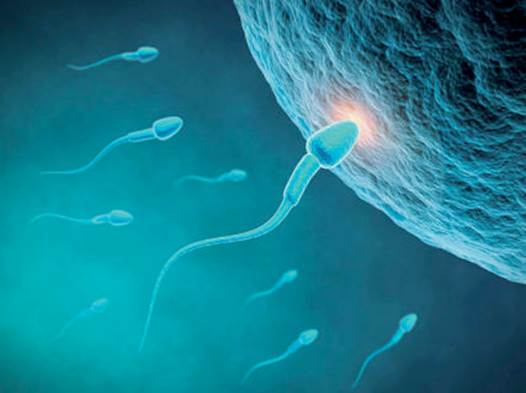Find out why more and more men are
struggling with infertility and what can be done about it.
Time was when reproduction, child bearing,
child rearing even the sex of the baby – were squarely, unfairly considered a
women’s prerogative. A childless woman was called barren and cast away, while
the man went his merry way.

Can
You Father A Baby?
Until scientific wisdom turned up that very
often a couple’s infertility in the past, was caused by the male.
Rubina tried long and hard for a baby,
undergoing a battalion of tedious test. While her in-laws cried for divorce, an
aunty surreptitiously steered the husband for a semen analysis, which turned up
a woefully inadequate sperm count.
Abe had fathered a daughter from his
divorced wife, so when wife No.2 did not get pregnant within two years, he
blamed her and dragged her to a stream of gynaecologists. The last one coaxed
him to come in for a routine semen test. The sperm count was almost nil. His
medical history showed that he had undergone an operation for hydrocele, a year
after his daughter had been born, which was responsible for the condition.
Gaurab and his wife Bina spent more than
five lakh rupees over the last 8 years in their quest for a baby. They offered
prayers in scores of temples and churches across India, swallowed fertility
boosting herbal pills and tonics by the clock, prescribed by countless vaids.
To date couple remains childless. And yet Gaurab has failed to take the most
important step – viz. a fertility test that would tell him conclusively whether
he can father a baby at all.
Lost Sperm
Researchers across the world have found
that sperm counts are dwindling. They blame an urban influenced lifestyle with
food, water, milk contamination, late marriages, delayed child bearing,
whatever.

Researchers
across the world have found that sperm counts are dwindling.
A decade or two ago a normal sperm count
was 40 to 50 million/sperm/per milliliter (ml). The WHO has now had to do a
rethink on this. Today’s normal is 20 million sperm per milliliter in a total
semen volume of 2 ml. Infertility has been marked down to below 15 million.
The total sperm count has also declined
from 73.6 million/ml in 1989 to 49.9 million/ml in 2006, according to a large
French study.
India is not far behind. The All India
Institute of Medical Science (AIIMS) states that while the sperm count of a
normal Indian male used to be 60 million per ml around 3 decades ago; it now
stands at around 20 million. There is also a drop in motility, healthy shape
and structure.
About 12 to 18 million couples in India are
diagnosed with infertility annually; nearly half is due to the male factor.
Fertility Wreckers
In order to be fertile a man must be able
to deliver an adequate quantity of normal sperm to a woman’s vagina and that
sperm must be able to find their way along the narrow neck of the cervix and
into the womb and up the fallopian tubes to fertilize the waiting egg.
Infertility is the inability to conceive
after regular intercourse for a year.
Any of the following conditions that
interfere with the above process can make a man less fertile.

In
order to be fertile a man must be able to deliver an adequate quantity of
normal sperm to a woman’s vagina and that sperm must be able to find their way
along the narrow neck of the cervix and into the womb and up the fallopian
tubes to fertilize the waiting egg
Too low: The
whole process of creating sperm is a delicately balanced matter. They are
manufactured continuously in the testes from puberty till the man is well over
sixty.
Poor sperm production may be due to damage
to the organs that produce them. This may lead to few sperm in the semen or
they may be deformed or weak or die quickly.
Too slow: A
sperm has to journey a long way, and like any other long distance runner, each
travels at its own pace. Although only one is needed to achieve pregnancy,
there must be at least 1,000 to make a joint attack on the tough layers
surrounding the eggs, until one manages to break through. Sluggish sperm are
unable to swim through the cervical mucus to meet the egg. So too semen that is
viscous due to an infection, is difficult to negotiate.
Scarring:
Surgery to repair hernia in babies can damage the testicular artery which could
lead to testicular failure in adulthood. An operation to remove the swelling in
the testicles (hydrocele) can damage the vas deferens and lead to an
obstruction in the passage of sperm, due to excessive tightening in the tail of
the Epidymisis.
Diseases that mar: STDs may lead to inflammation of the ejaculatory passage and
absence of healthy sperm. TB of the Epidymisis, small pox and filaria resulting
in hydrocele can also cause sterility. Mumps can lead to testicular
inflammation and atrophy. Varicose veins in the spermatic cords can lower sperm
counts. Even a severe attack of flu or hepatitis can reduce the function of the
testes from 3 to 9 months.
Heating up:
Nature intended that the male testes hang in the scrotum outside the body to
remain at a 3° cooler temperature than the rest of the body. That’s why
anything that heats them up can play havoc with a man’s ability to father a
baby. Even a one-degree elevation in testicular temperature leads to sperm
depression.
Hormonal or genetic disorders: may interfere with sperm production such as hyper prolactinemia
(excessive prolactin’s in the blood), low thyroid levels, shrunken or
undescended testicles, adrenal gland and pituitary gland dysfunction. Genetic
disorders are abnormalities in the sex chromosomes.
Sperm depressing drugs: Top sperm affecting culprits are anabolic steroids, aspirin taken
for long stretches of time, cimetidine (for ulcers), Colchicines (for gout), clotrimazole
(for fungal infections), antimalarials, and estrogens to treat prostate cancer,
methotrexate (for cancer, arthritis rheumatoid), spironolac tone (for
hypertension), sulfasalazine (rheumatoid arthritis), and some anti-depressants.
A dry run:
Retrograde ejaculation happens to men whose prostate has been removed, and in
diabetics. The semen moves into the bladder instead of down the penis.
Toxic tobacco…: influences the mobility of the sperm by affecting the tail function
as well as the oxygenation of the testes. The testicular artery may go into
spasm or narrow because it is choked with tobacco.
… And recreational drugs: Marijuana, cocaine and opioids alter hormonal balance and
testicular function, resulting in lower sperm count and abnormal sperm.
The demon drink: Alcohol impairs liver function resulting in excessive levels of the
female hormone estrogen, which suppresses sperm and shrinks the testes.
Occupational hazards: Toxic chemicals that affect the hormonal balance and sperm quality
are lead, petrochemicals, insecticides, pesticides, nickel, anaesthetic gases,
Agent Orange – although they act slowly.
Your swimmers’ stats
A mature sperm consists of a capped oval
head, neck and a tail. It’s 55 microns long, the head is 3 to 6 microns, the
neck 8 microns, the tail 45 microns. One micron is a millionth of a millimeter.